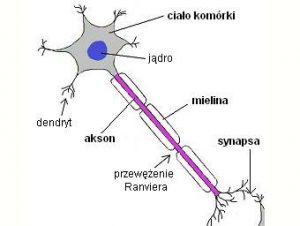The role of white matter in learning and mental illnesses


Last modified: 29-03-2020
The nervous system consists of gray matter and white matter. Grey matter is found mainly in the cortex, and is composed of the cell bodies of neurons (“gray cells”). White matter is nerve cell bodies projections (axons), which transmit information from the cell bodies to synapses connecting the neurons to each other. The majority of axons are coated with a layer of white substance – myelin, produced by glial cells. There are two types of glial cells: the oligodendrocytes that form the myelin in the central nervous system, and Schwann cells, which form it outside of the central nervous system. The rate of impulse conduction through the axons depends on whether axon is myelinated (coated with a myelin conducts information faster) and the ratio of the diameter of a naked axon to the total diameter of the fiber (i.e., with myelin). For many years, scientists have focused their research on the gray matter, but the new neuroimaging technique called diffusion tensor imaging (DTI) made it possible to examine also the white matter.
The role of white matter in learning
Myelin sheaths are formed in different periods of life. In the prenatal period myelinated axons are found only in certain areas of the brain, after birth rapid increase occurs, and in some areas the completion of myelination occurs only at the age of 25-30 years. At the latest axons are covered in the frontal lobes, which are responsible for causal reasoning, judgment, planning and probably just deficiency of myelin in these areas is the cause of teenagers’ inability to make mature decisions.
Frederik Ullen from the Stockholm Brain Institute examined white matter in people playing the piano professionally and in non-musicians. It turned out that professional pianists have better developed those areas of the white matter that connect the cortex of the brain responsible for the coordinated movement of the fingers with the areas involved in other cognitive processes that occur during piano playing. It was also shown that the more time each day musician was exercising, the more axons in the white matter were covered with myelin and more tightly arranged. Neurobiologist William T. Greenough further demonstrated that rats developing in an environment rich in various toys have more myelin at the axons of the corpus callosum, which connects the two hemispheres of the brain. The study of children aged 5-18 years also shows that better development of white matter correlates with higher IQ.
The role of white matter in mental illnesses
Recently, Klaus-Armin Nave from the institute in Göttingen discovered how Schwann cells regulate the thickness of the myelin, so that impulse conduction velocity was optimal. They detect the protein neuregulin, which covers the axons. The decrease or increase in the amount of this protein results in formation of less or more layers of myelin. Many people suffering from bipolar disorder (periods of mania and depression), and schizophrenia has a defective gene regulating the production of neuregulin.
Damaged or missing myelin in the central nervous system is the cause of multiple sclerosis, cerebral palsy and Alexander disease. Children with deadly Alexander disease, which is characterized by abnormalities of myelination and mental retardation have a mutation in the gene responsible for the proper functioning of astrocytes – cells that stimulate oligodendrocytes to production of myelin.
White matter may also play a role in dyslexia. Its cause is time coordination interference in flow of electrical impulses in the circuits responsible for reading, and the cause of such interference can be underdevelopment of the white matter. White matter abnormalities have also been detected in patients with a lack of hearing music, speech-impaired, in patients with ADHD, autism, senile dementia, Alzheimer’s disease, and even in people with pathological tendency to lie.
It is possible that hypoplasia or myelin damage is the result of, not the cause of a bad flow of signals between neurons. This hypothesis contradicts admittedly Gabriel Corfasa from Boston, who has demonstrated, studying mice that experimental disruption of gene action in oligodendrocytes causes changes in behavior resembling schizophrenia. However, it seems that most probable is theory, according to which the mechanism is bilateral – gray matter affects white and white matter affects the gray.
References:
R. Douglas Fields “Biała eminencja”, Świat Nauki, 04/2008
Author: Maja Kochanowska






Add comment